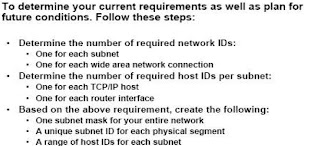Finding of Host on the Same/Different Networks
Process of Finding Hosts on the Same Network Segment- ARP
Assume that host A and host B are on the same LAN. Host A broadcasts an ARP request onto the LAN looking for host B. Because it is a broadcast message all devices on the LAN, including host B, process the request. However, host B is the only device to respond and it does so with its MAC address. Host A receives host B reply and stores the MAC address in local memory. This is often called an "ARP cache". The next time host A needs to communicate with host B it recalls host B stored MAC address.
Process of Finding Hosts on the Different Network Segment- ARP + Router
Let's look at how host Y communicates with host X on a different LAN, which it can access via router A.
As before host Y broadcasts its ARP request. Router A, along with all the other devices on the LAN, processes the request. It knows that host X will not see the request because it is on another LAN, and that any packets destined for host X will have to be relayed. So instead, router A provides its own MAC address to host Y as a "proxy" reply to the ARP request. Host Y receives the router's response and saves the MAC address in its ARP cache memory. The next time host Y needs to communicate with host X, it recalls the stored MAC address of router A.
Assume that host A and host B are on the same LAN. Host A broadcasts an ARP request onto the LAN looking for host B. Because it is a broadcast message all devices on the LAN, including host B, process the request. However, host B is the only device to respond and it does so with its MAC address. Host A receives host B reply and stores the MAC address in local memory. This is often called an "ARP cache". The next time host A needs to communicate with host B it recalls host B stored MAC address.
Process of Finding Hosts on the Different Network Segment- ARP + Router
Let's look at how host Y communicates with host X on a different LAN, which it can access via router A.
As before host Y broadcasts its ARP request. Router A, along with all the other devices on the LAN, processes the request. It knows that host X will not see the request because it is on another LAN, and that any packets destined for host X will have to be relayed. So instead, router A provides its own MAC address to host Y as a "proxy" reply to the ARP request. Host Y receives the router's response and saves the MAC address in its ARP cache memory. The next time host Y needs to communicate with host X, it recalls the stored MAC address of router A.


Comments
Post a Comment